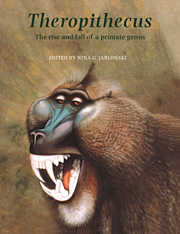Book contents
- Frontmatter
- Contents
- List of Contributors
- Preface
- Acknowledgements
- 1 Introduction
- PART I Fossil evidence and phylogeny
- 2 Theropithecus darti from the Hadar Formation, Ethiopia
- 3 Evolution of Theropithecus in the Turkana Basin
- 4 Are Papio baringensis R. Leakey, 1969, and P. quadratirostris Iwamoto, 1982, species of Papio or Theropithecus?
- 5 Theropithecus fossils from Africa and India and the taxonomy of the genus
- 6 Theropithecus from Ternifine, Algeria
- 7 The Phylogeny of Theropithecus
- PART II Biogeography and evolutionary biology
- PART III Anatomy of the fossil and living species of Theropithecus
- PART IV Behaviour and ecology of living and fossil species of Theropithecus
- Appendix I A partial catalogue of fossil remains of Theropithecus
- Appendix II Conservation status of the gelada
- Index
5 - Theropithecus fossils from Africa and India and the taxonomy of the genus
Published online by Cambridge University Press: 11 November 2009
- Frontmatter
- Contents
- List of Contributors
- Preface
- Acknowledgements
- 1 Introduction
- PART I Fossil evidence and phylogeny
- 2 Theropithecus darti from the Hadar Formation, Ethiopia
- 3 Evolution of Theropithecus in the Turkana Basin
- 4 Are Papio baringensis R. Leakey, 1969, and P. quadratirostris Iwamoto, 1982, species of Papio or Theropithecus?
- 5 Theropithecus fossils from Africa and India and the taxonomy of the genus
- 6 Theropithecus from Ternifine, Algeria
- 7 The Phylogeny of Theropithecus
- PART II Biogeography and evolutionary biology
- PART III Anatomy of the fossil and living species of Theropithecus
- PART IV Behaviour and ecology of living and fossil species of Theropithecus
- Appendix I A partial catalogue of fossil remains of Theropithecus
- Appendix II Conservation status of the gelada
- Index
Summary
Summary
The female Theropithecus skull from Swartkrans, South Africa, SK 561, is described for the first time after reconstruction by R. Clarke. It is closely similar to female crania from Kanjera, but the anterior dentition is better preserved. The probable male cranium SK 599 lacks a face or teeth, but is most likely referable to Papio (Dinopithecus) ingens on the basis of its short postglenoid processes. Several isolated teeth from Brain's recent excavations at Swartkrans demonstrate no significant size increase from members one to three; this suggests only a short span of time (perhaps less than 0.25 Ma) separated these horizons, rather than the 1+ Ma originally suggested by Brain.
The first fossil Theropithecus specimen ever published, a single lower molar from Ain Jourdel, Algeria, is described. It is a typical M1 of a small species whose only distinction is the acute angle formed at the base of its median lingual notch. The distal humerus from Garaet Ichkeul, Tunisia, is probably from a macaque (rather than a Theropithecus, as suggested by Geraads).
The isolated Theropithecus molar from Lothagam-3, Kenya, is described. It is a slightly damaged and moderately worn tooth, probably M2, of a size comparable to several Plio- Pleistocene species of the genus. Its crown complexity and relief is high, and as it probably dates to between 4.0–3.3 Ma, it is unlikely to be a member of the T. brumpti lineage, whose early members have weakly complex molar crowns.
Two Theropithecus molars are described from Kanam East, Kenya. Although heavily worn, they compare most favorably with the Hadar sample of T. darti, which corresponds to a suggested earlier Pliocene age for the deposits.
[…]
- Type
- Chapter
- Information
- TheropithecusThe Rise and Fall of a Primate Genus, pp. 157 - 190Publisher: Cambridge University PressPrint publication year: 1993
- 37
- Cited by



